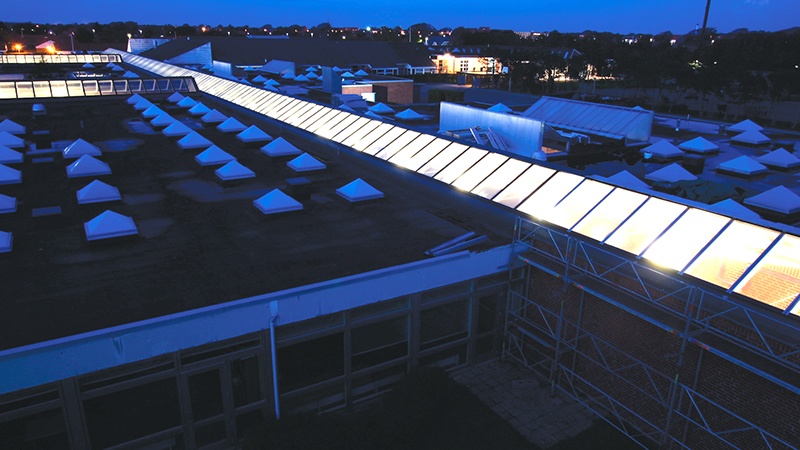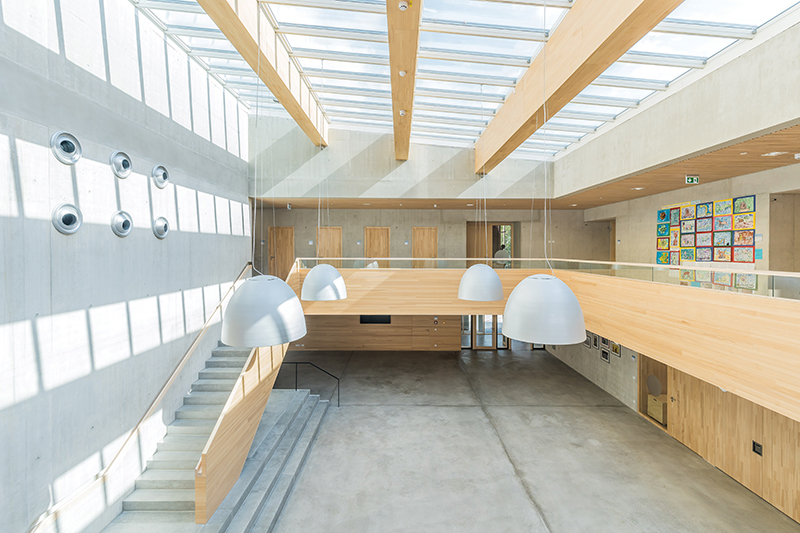The design of building envelopes can have a significant effect on lighting in a building, and on the wellbeing of its occupants. This CPD, in partnership with Velux Commercial, explains.

As good as some artificial lighting is, no electric light source has yet been created that can match the quality of natural light or mimic the variation in its spectrum throughout the course of a day, a season, or a year. All of which puts a focus on ‘daylighting’, or the controlled use of natural light in and around buildings.
Humans have evolved circadian rhythms and our building designs should reflect the importance of those rhythms. It is possible to create indoor environments that not only provide a good visual experience and high levels of visual comfort, but which are also in tune with the physiology of the occupants. This CPD article looks at the role of natural light in human health and how commercial buildings can be designed to achieve genuinely ‘human-centric’ daylighting throughout the building fabric.

Daylight and everyday life
The non-visual aspect of light is every bit as critical to how the body functions during the day as the light we use to see.
Circadian rhythms
This is where circadian rhythms enter the equation, the human body’s natural response to changing light levels including the production of different hormones at different times. The hormone melatonin governs our pattern of wakefulness and sleep and the type of light to which we expose ourselves plays a role in managing the cycle.
Exposure to ‘cooler’, more distributed, blue-rich light during the day suppresses the production of melatonin and maintains alertness by effectively encouraging the production of serotonin, dopamine and cortisol. Following this with ‘warmer’ and more focused light during the evening stimulates the release of melatonin and helps people to feel sleepy.
Good lighting and true ‘human-centric’ lighting combine both visual and non-visual aspects to stimulate the correct physiological responses and promote good health.
Daylight for health
Usually, we do not receive enough daylight and often the 24-hour nature of society then exposes us to too much light during the hours of darkness.
During the day, humans need light that is high in ‘melanopic content’ followed by light that is low in melanopic content during the evening (and then darkness). This is why exposure to natural light is so important when thinking about building design.
When it comes to quantity, indoor light is typically a whole order of magnitude lower than outdoor light. A sunny summer’s day can provide an illuminance of up to 100,000 lux. Even on a grey and cloudy day 5,000 lux of illuminance is possible. By contrast, indoor lighting might be designed to offer just 200 or 300 lux.
The impact of being indoors
It is popularly held that people spend around 90% of all our time indoors. The light we are usually exposed to indoors, as well as offering a much lower illuminance than natural light, is not dynamic. It has a constant colour temperature and our bodies do not respond to it in the same way.
The circadian rhythm is still evident in people with a ‘typical’ 9 to 5 office job, but its peaks and troughs are not as pronounced. Feelings of sluggishness are likely as well as making it harder to get to sleep. By contrast, seeing daylight early in the day appears to start the process of getting the body ready for sleep later that night and can even mitigate exposure to bright light later in the day.
Lighting and building design
Commercial pressures on building design commonly result in office buildings where around a third of employees have no access to daylight. European building standards have helped to avoid a similar crisis in occupant comfort and the publication of EN 17037 should ensure that daylighting only improves in buildings throughout Europe.
There is little doubt that daylight should be a significant component of a building design that claims to embrace human-centric lighting. This section looks at how different parts of a building may be designed to properly account for daylight and to provide naturally well-lit spaces.
Walls
Tall buildings with fully glazed facades will always possess a ‘wow’ factor. But it is important to ensure a building that isn’t just attractive from the outside, but also provides a comfortable internal environment.
All too often, fully glazed buildings offer little consideration for the heating and cooling loads, and energy demand that such a design imposes. Occupants will have a good view to the outside, but at what cost in terms of over-exposure to daylight and glare, and reliance on mechanical systems for internal temperatures and ventilation?
A glazed facade might look like a clever or intricate design, but intelligent design involves delivering a healthy interior without consuming more resources than a building needs to. That means selecting the appropriate size and location of window openings to maximise daylight while minimising heat losses.
Floors
It may sound strange to think about floors as part of daylighting, but they do have a role to play. Shiny and bright surfaces can cause glare, but light colours improve visual comfort.
Then there is the size of the floor area itself and, more specifically, the depth to which it penetrates the building interior. Sometimes referred to as the floor plate, the deeper the floor area and the further that parts of it are from the facade windows the harder it is to serve with an appropriate level of daylight.
Roofs
Where floor areas are too large or deep, or where site constraints or external obstructions restrict access to daylight, facade glazing alone is unlikely to meet the daylighting requirements of a building. This is where roof glazing solutions come in.
Good use of unobstructed roof glazing can help to achieve better illumination and balance glare from facade glazing. Like the walls of a building, orientation influences the availability and quality of daylight in the interior.

It is also worth considering that roof areas may offer glazing options where there is a restriction on what can be done with the walls. While it’s tempting to think that new-build projects tend to offer unrestricted possibilities, there are often constraints – and the constraints on a refurbishment project can be even more onerous. While the quality of a view through roof glazing may not be as varied as can be achieved with facade glazing, it is better placed to offer an unrestricted view of the sky and help further a sense of connection with the outdoors.
Atria
Generally speaking, an atrium is a way of bringing the outside in – a space that is sheltered from the elements while giving building users a connection to the external environment.
The glazing to an atrium therefore falls under different criteria to the roof glazing described above. Where ‘standard’ roof glazing is primarily intended to light an individual space, an atrium can also offer the potential to ‘harvest’ daylight. It brings natural light into a large central space, from where other parts of the building can then benefit without needing direct access to facade glazing.
Terraces and outdoor spaces
However well designed a building is, when it comes to access to daylight there is no substitute for being outside. Ensuring the availability of high-quality outdoor space can help encourage people to leave a building and enjoy access to daylight.
A roof terrace has the potential advantage of offering unobstructed access to daylight at any time of day (subject to the position and height of any surrounding buildings). There is arguably greater scope for the design of outdoor spaces at ground level, providing not only daylight but also contact with nature that may have its own mental health benefits.
For example, rather than the path between an office building and its car park being across a featureless expanse of grey roads and pavements, could it be a short wooded walk instead?
Conclusion
For any building’s lighting strategy to be considered truly human-centric, it should incorporate daylight as much as possible to provide well-lit, dynamic and comfortable internal spaces. Not only does daylight provide a higher level of illumination, it also helps maintain the circadian rhythms of the building’s occupants.

EN 17037: The European Daylight Standard
The new standard addresses the provision of daylight in buildings.
EN 17037, which came into effect at the end of 2019, is the first European Standard to deal exclusively with the design and provision of daylight in buildings.
What does this standard cover?
To achieve its multiple aims in respect of daylighting and occupant comfort, EN 17037 covers four different areas:
Daylight provision
Daylight provision, or illuminance levels, allows users to carry out tasks and plays a part in determining the likelihood of artificial lighting being switched on. Assessment can be via either climate-based modelling or daylight factor calculations.
Assessment of window views
Building users should have a large, clear view of the outside. EN 17037 considers the width and outside distance of the view, as well as landscape ‘layers’ (sky, landscape and ground). The view should be perceived to be clear, undistorted and neutrally coloured.
Access to sunlight
Calculating access – or exposure – to sunlight is a comfort and health factor for users of dwellings, nurseries and hospital wards. Daily sunlight exposure can be established through detailed calculation or table values.
Prevention of glare
Prevention of glare is concerned with removing the probability of glare for building users, especially those who do not choose where they sit. It uses a detailed calculation of daylight glare probability (DGP), or a standard table of values for sun-screening materials.
VELUX Commercial has a dedicated EN 17037 white paper covering everything you need to know about this daylight standard. It is available here
This article has been created by Construction Manager in partnership with VELUX Commercial




